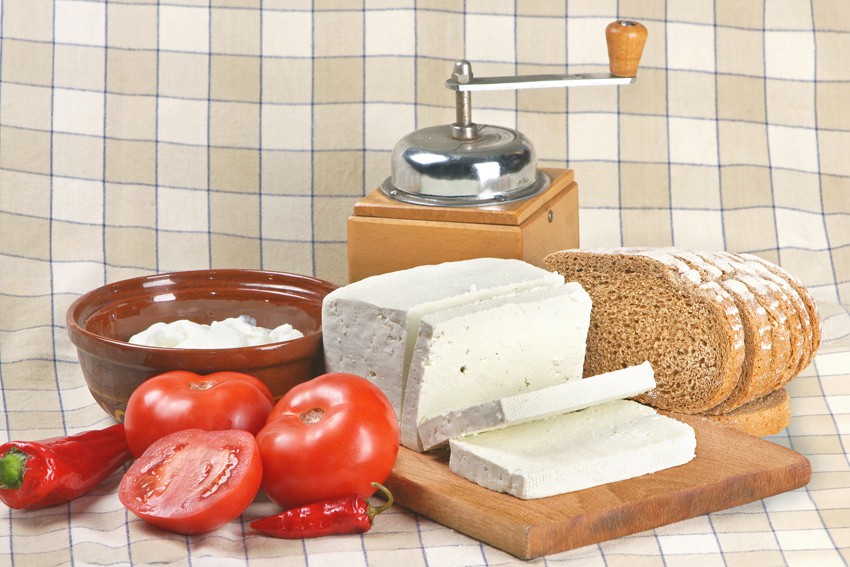Fabulous Feta

As a Greek, feta featured in our dining experiences in many ways, and there was a crisis should the fridge be feta bare!
I would dawdle behind her like a duckling as she constantly ushered me on. When we arrived at the store the one thing that overcame me time and time again was the smell. I occasionally get aromas reminiscent to this in some stores now, but nothing like the intensity of aroma from this tiny little store on Glen Osmond Road: A mixture of food from many cultures, strong freshly ground coffee, charcuterie, freshly baked breads, sweets, liqueurs, cheese and the list just goes on. I relished these visits because I would get a treat from the Italian lady and one from my grandmother – double luck!
I would always ask for a freshly baked horseshoe roll with sesame seeds, which the Italian lady would cut for me and insert a slab of feta and the most exquisite thinly-sliced capicollo. She would give me a small piece of deli paper to hold on to it and then I was set. Treats in pocket, or firmly secured in one hand, freshly made roll in the other hand, ready for the big walk home.
As a Greek, feta featured in our dining experiences in many ways, and there was a crisis should the fridge be feta bare! Feta is used as an appetiser, side dish and as an ingredient in salads, pies and pastries. Its use in Greek dishes is almost as important as the use of olive oil. In summer my grandmother would serve visitors some feta along with sweet, crisp, ripe watermelon and ouzo on ice in delicate little glasses (the Greek sherry, perhaps) as a welcoming refreshment, definitely worth a try!
In 1994, Greece asked for feta to be protected under a Protected Designation of Origin (PDO). After a 13-year battle with Denmark, France, and Germany (who also produce cheese under the name feta), Greece was finally granted the PDO. The PDO status began in the EU in 1992, as a way to protect specific foods and maintain their authenticity. Greeks consume 12kg of feta cheese per person, per year!
Originally feta was made from a blend of ewe and goat’s milk; this allowed excellent acid development during the cheesemaking process. This is unlike feta made from cow’s milk, which tends to be a little too rich for this style of cheese. While feta is a relatively simple cheese to make, the yields are quite low. This has seen many Australian cheesemakers stop making feta from goat’s milk partly due to the lack of milk supply, as well as the fact the other cheese varieties, particularly fresh cheeses, can yield up to three times more. There are many varieties of feta on the market, some soft and creamy, others firmer and crumbly. Each having its place depending on what you are planning to do with it.
Alas, not all feta is the same. My inspiration to make a feta with a difference came when I met with cheese specialist Will Studd after he had been to Greece. He told me he had visited a Greek cheesemaker producing barrel-ripened feta, and this was the traditional way feta was matured. I liked the idea and I was quite keen to give it a go. Our winemaker at Coriole made up some special barrels for me. The barrels were previously used for fermenting Shiraz and were rich and red on the inside with the nose to suit. The barrelhead was converted into a lid as our access point. After rubbing the barrels with salt and whey brine we gently immersed the freshly made goat feta (some 100kg per barrel) into the barrels. Litres of whey topped up the barrel before the lid was firmly secured and the cheese put to rest to ferment. Cheesemaking has taught me a degree of patience, however in this instance my curiosity overwhelmed me as I squirreled off small tastings at regular intervals. The cheese is now around four months old and delicious. It is creamy and milky with developed flavours and an intense aroma of oak and fine Shiraz notes. Uniquely different to any other feta I have tasted or produced.
There are still a handful of small family dairies that produce this traditional treasure in Greece. How I love learning such traditions and bringing them alive in our relatively young cheesemaking nation. I am sure my grandmother would have loved this little beauty with her Ouzo treat!
Kris Lloyd is Woodside’s Head Cheesemaker.